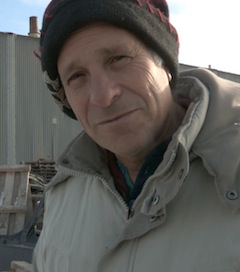Whistleblowers have told Britain's “Dispatches” that the safety software on major US pipelines contains deliberate errors – and so pipelines can – and have – busted, leaked, exploded … and killed.

Greg Palast in front of the BP PIG shed, Alaska 2010.
Congressional Republicans are holding extended unemployment benefits hostage until President Obama agrees to speed up approval to build the XL Keystone pipeline. XL Keystone will slice down through the entire width of the USA, moving tar-sands oil from Canada to Houston.
The oil industry promises that the pipeline will be safe. But the pipe is only safe if the PIG inside it can squeal.
Federal law requires the industry to run a diagnostic robot PIG, a pipeline Inspection Gauge, that will squeal when something is wrong: a crack, dangerous corrosion, anything that might lead to a spill or explosion.
But PIGs are only as good as the software that tracks and analyzes their signals. And the software used by Big Oil has been compromised – deliberately.
Insiders told this reporter that the software was designed to fool the safety inspectors.
“The software feeds them incorrect information about the state of their pipeline.”
This source knows what he's talking about: It was his team that designed the software with the known flaw. But so what?
The insider, quite nervous, told Britain's “Dispatches,” “If they don't repair the pipelines the worst that can happen is similar to the disaster that we had near San Francisco, where a natural gas pipeline exploded and killed 9 people.”
The insider – identified as Pig Man No. 1 – appeared on “Dispatches,” Britain's equivalent of “60 Minutes,” including the segments not yet broadcast.

Pig Man No. 1 in shadow.
Originally, our source thought that the deadly software code was an error – so, he tried to fix it to meet the standards of the law.
“I was part of a team that corrected the error.”
But the error was deliberately left in place, and the correction hidden. “Because the software would increase the liability that a pipeline operator would, in this case a subsidiary of BP, would have to deal with.”
Pig Man No. 1's story was corroborated by another member of the software team, too scared to come on camera, even in shadow, following a threat by the industry contractor hired by BP and other majors to design the software.
“Dispatches” provided the information to BP, which said it complied with all rules and regulations.
That's a reasonable alibi for BP, except that one of the nation's premier public-interest lawyers doesn't buy it. Robert F. Kennedy Jr., dean of environmental law studies at Pace University in New York notes that “the dog didn't bark,” that is, when the Trans-Alaska pipeline burst and then exploded, when pipes cracked in Yellowstone National Park and underneath homes in California, the companies didn't turn around and sue their software contractor for failures which costs millions of dollars in fines – and several lives.
Why not? Why is Big Oil happy with what they call a “smart PIG” that's often real stupid? Is it because the dumber the PIG, the less sensitive the software, the more they save? Sometimes, the industry quietly skips the “pigging” altogether.
After all, a few million in fines and payments to bereaved families adds up to a cheap license to pollute.
Making the diagnostic software less sensitive is like pulling the battery out of a smoke alarm. God forbid you have a fire. But in the case of the PIG, it's not just dangerous, it's illegal. The whistleblower saw that the software violated the very specific requirements of the law, and tried to fix what he thought was an accidental error.
And by the way, I'd like everyone reading this to say a quiet “Thank You,” to Pig Man No. 1. Even speaking in shadow, he took a gamble on his career, on a threat of financial ruin by the company who made all the engineers aware of the problem sign papers that they would never discuss nor reveal anything about this software and its deadly errors. That's guts; that's courage.
But that brings us to the XL pipeline. This pipeline, which will benefit BP, Shell Oil, Chevron, the Koch brothers' Flint Hills Resources, will be safe, just as BP swore to Congress in November 2009 that all is A-O.K. with drilling in the Gulf of Mexico's deep water.
We have good reason to fear the PIG in the XL pipeline and, given the history of this crew, even more reason to fear the pigs that own it.
Read more about Pig Man and the industry in this excerpt from Greg Palast's new book “Vultures' Picnic: in Pursuit of Petroleum Pigs, Power Pirates and High-Finance Carnivores.”
Join us in defending the truth before it’s too late
The future of independent journalism is uncertain, and the consequences of losing it are too grave to ignore. To ensure Truthout remains safe, strong, and free, we need to raise $33,000 in the next 2 days. Every dollar raised goes directly toward the costs of producing news you can trust.
Please give what you can — because by supporting us with a tax-deductible donation, you’re not just preserving a source of news, you’re helping to safeguard what’s left of our democracy.
